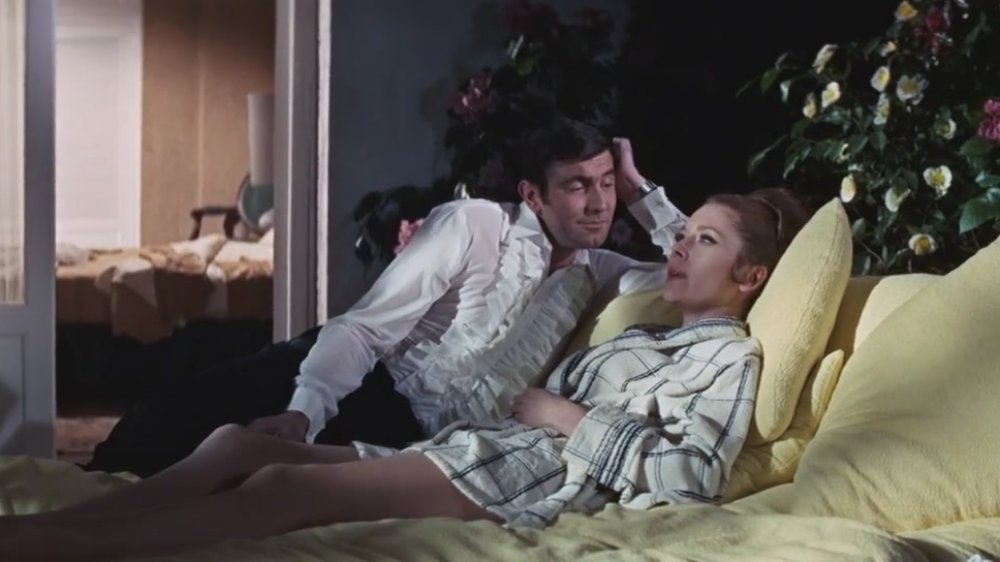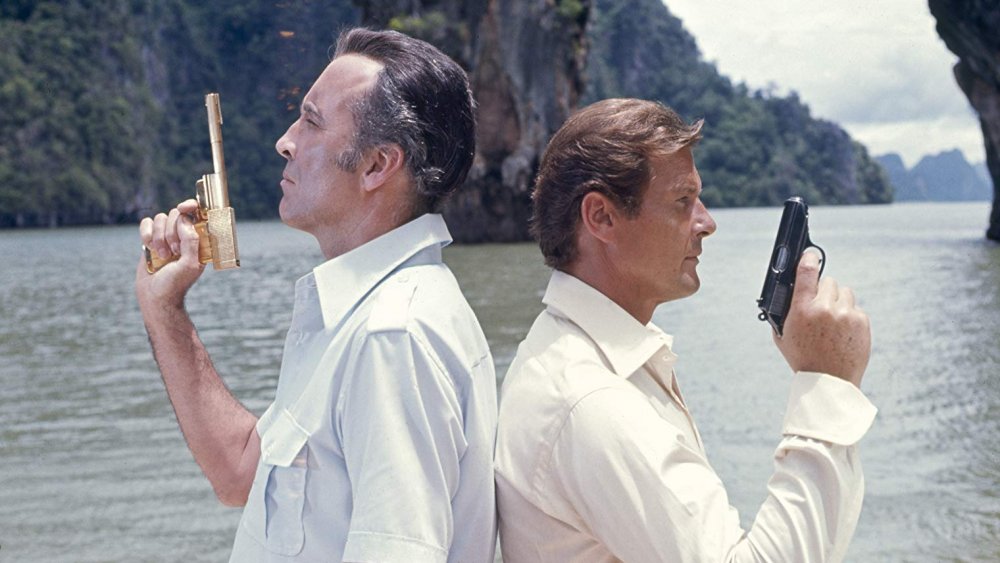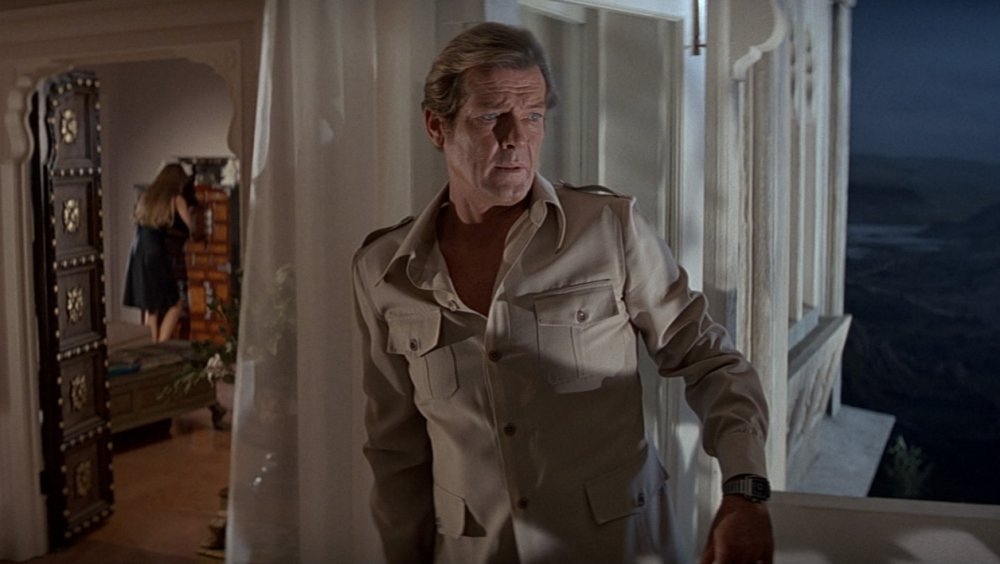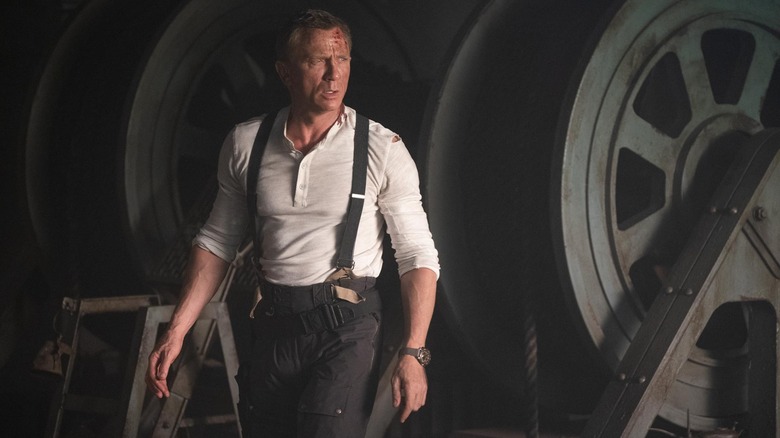The Entire James Bond Timeline Explained
In 1962, Eon Productions released "Dr. No," its first adaptation of Ian Fleming's bestselling series of James Bond novels. The film, about a suave, deadly, and witty secret agent uncovering a mad scientist's plot in the Caribbean, was a massive hit, and launched one of the longest-running and most successful media franchises of all time.
More than five decades later, James Bond is still going strong. Six different actors have played the legendary Agent 007 over the course of more than two dozen films in Eon's series, and as a result of the films' popularity Bond's life has also continued in novels, comics, and even a few non-canonical films. James Bond is a survivor, not just in pop culture but in the many cinematic stories of his adventures. With that in mind, let's take a loving look back at Bond's many missions in the long-running Eon Productions series. This is the James Bond timeline, explained.
Early life
While a great many Bond adaptations don't spend much time alluding to his early life, creator Ian Fleming did establish a background for his legendary secret agent, much of which has remained intact in one way or another throughout the decades since 007's debut. Bond was born to a Scottish father and a Swiss mother, and spent much of his early childhood on the European continent due to his father's work. When he was 11, both of his parents were killed in a mountain climbing accident, and young Bond was placed in the care of his aunt. He then attended Eton and Fettes, completing his education early, and lied about his age to enter and join what would later be called the Ministry of Defence in 1941. He joined the Special Branch of the Royal Navy Volunteer Reserve, doing confidential work as a lieutenant, and by the end of World War II he had been promoted to the rank of Commander. After the war he continued covert work for the Ministry, earning the rank of Principal Officer of the Civil Service. Later, he recorded his first two kills as a secret agent, earning him the "00" status of the films.
As is pretty much par for the course with any enduring franchise, the James Bond timeline has often been tweaked in various adaptations. That being said, Bond's naval service and subsequent secret work for the Ministry of Defence, as well as his tragic childhood, have remained near-constant parts of his backstory.
First battles with SPECTRE
The first film in the Eon Productions Bond series, "Dr. No," featured Bond traveling to Jamaica to investigate the death of the MI6 station chief there. Bond's subsequent investigation, which included multiple attempts on his life, led him to Crab Key, and a radioactive area guarded by a "dragon," which turned out to be a tank with a flamethrower attached. There, Bond and his companion Honey Ryder discovered the lair of Dr. Julius No, a brilliant scientist who'd been recruited by the evil organization known as SPECTRE (Special Executive for Counter-Intelligence, Terrorism, Revenge, and Extortion). No's plan involved using his advancements in radiation to disrupt the upcoming launches of the Mercury space program. With Ryder's help, Bond was able to sabotage the effort, kill No, and destroy his lair. His success in stopping Dr. No led to a vow of vengeance from SPECTRE leadership that would haunt Bond for years, adding a consistent through line to a franchise that could frequently be fairly episodic in nature. "Dr. No" also introduced a key Bond ally, CIA Agent Felix Leiter, who would assist him in numerous future missions.
"From Russia with Love" introduced more of the SPECTRE leadership, including the mysterious Number One, and featured assassins attempting to lure Bond to his death by stealing a Russian cryptographic device. Though several SPECTRE killers pursued him, Bond was able to both free the device from SPECTRE control and kill his own would-be killers, setting the stage for future acts of vengeance. The film also introduced Bond's beloved equipment master, Q.
Thwarting global domination
With "Goldfinger," Bond left SPECTRE behind for a bit to focus on Auric Goldfinger, a gold-obsessed megalomaniac who, with the help of a smuggled nerve gas, planned to detonate a dirty bomb in Fort Knox to make the U.S. supply of gold inside useless. This would increase the value of Goldfinger's own personal gold horde and plunge the world into economic chaos. Bond was able to thwart Goldfinger's plans with the help of one of his former collaborators, the pilot Pussy Galore. Goldfinger also introduced another key part of the Bond mythos: His Aston Martin spy car, complete with ejecting passenger seat.
"Thunderball" featured the return of SPECTRE and a plot led by Emilio Largo, Number Two in the organization's hierarchy, to hijack a pair of nuclear bombs from NATO and hold the world hostage. With the help of Largo's former mistress, Domino, Bond was able to infiltrate Largo's home and yacht and foil the plan, killing Largo in the process.
"You Only Live Twice" featured yet another encounter with SPECTRE, including the organization's mysterious leader, Ernst Stavro Blofeld. With the help of the head of the Japanese secret service, Bond went undercover to find SPECTRE's secret volcano lair, where a plot to steal US and Soviet spacecraft and covertly start World War III was underway. With numerous Japanese operatives fighting alongside him, Bond defeated Blofeld, but did not kill him.
The brief marriage of James Bond
"On Her Majesty's Secret Service" is the only Bond film to star George Lazenby as 007, and it's also one of the most consequential films in the franchise. In that film, Bond is tracking Blofeld when he meets Teresa "Tracy" di Vincenzo, who he began to romance after saving her from a suicide attempt. Tracy's father, the head of a massive European crime syndicate, encouraged the romance, and Bond agreed to keep seeing Tracy in exchange for information about Blofeld.
Bond's investigation into the head of SPECTRE ultimately led him to the Swiss Alps, where Blofeld established a clinic claiming to cure people of their allergies. In reality, Blofeld had brainwashed 12 women to be "angels of death," who would be biological weapons which sabotage the food supply of the world. Bond's boss, M, agreed to Blofeld's ransom terms, but because Blofeld captured Tracy, Bond decided to mount an attack on the facility anyway. Bond, with the help of Tracy's father and his allies, was able to thwart Blofeld's plan, but failed to capture the head of SPECTRE. When they reunited, Bond and Tracy were married, but the union was cut tragically short. Blofeld and his operative Irma Blunt staged a drive-by shooting on Bond's parked car, and while 007 survived, his new bride was killed. Tracy's death would continue to haunt Bond for years.
A changing of the guard
"Diamonds Are Forever" marked the final time in the Eon series that Bond would be played by Sean Connery, and featured 007 battling Blofeld yet again. This time, the head of SPECTRE was revealed as the mastermind behind a diamond smuggling ring and the construction of a diamond-encrusted satellite laser that could detonate nuclear weapons from space. Blofeld planned to auction the satellite off to the highest bidder, but Bond was once again able to stop him.
"Live and Let Die" marked the beginning of the Roger Moore era of Bond, an era that featured no major SPECTRE stories and instead relied on a slightly more standalone style. In that film, Bond traveled to the Caribbean island of San Monique to investigate the deaths of three different MI6 operatives in less than 24 hours. There, he uncovered a plot by the island's leader, Dr. Kananga, to distribute free heroin in a chain of restaurants, and thus increase drug addiction and therefore drug sales around the world. The whole operation was disguised by a cloud of voodoo-based terror to prevent locals from asking too many questions. With the help of Kananga's advisor Miss Solitaire, Bond was able to stop the operation.
New kinds of killers
In his next two adventures, Bond would encounter several different kinds of killers who would challenge his place as the world's deadliest secret agent. In "The Man with the Golden Gun," Bond received a golden bullet from the titular assassin, a reclusive millionaire named Francisco Scaramanga. Though M pulled Bond back from official business, 007 set out to track down Scaramanga himself, and ultimately learned that Scaramanga had stolen a device that could change the future of energy production and disrupt the world economy. The two battled on Scaramanga's remote island home near China, and Bond ultimately defeated the man with the golden gun.
"The Spy Who Loved Me" saw Bond investigating a series of vanished submarines owned by both British and Soviet navies. He was forced to team up with Soviet spy Anya Amasova, and the two uncovered a plot by billionaire scientist Karl Stromberg to start a nuclear war using the submarines. Bond and Amasova were able to infiltrate Stromberg's underwater lair, where he planned to start civilization over after World War III was fought, and stop nuclear missiles from reaching New York and Moscow. "The Spy Who Loved Me" also introduced one of Bond's most memorable opponents: The metal-toothed assassin known only as Jaws.
James Bond goes to space
Over the course of his next four movies, Bond would traverse the world while dealing with everything from mad scientists to power-hungry Russian generals. In "Moonraker," Bond teamed with CIA agent Holly Goodhead to stop industrialist Hugo Drax from wiping out the world's human population via deadly nerve gas and starting a new "perfect" civilization from a secret space station.
In "For Your Eyes Only," Bond teamed up with a vengeful young woman to stop a secret British targeting computer from falling into Soviet hands. Before the action really got started, though, Bond spent the cold open of that film dealing with a bit of old business, visiting his wife's grave and battling a slightly disguised version of Blofeld before killing him. In reality, Blofeld had been removed from Moore-era Bond films for legal reasons, and this was the franchise's tongue in cheek way of addressing that.
In "Octopussy" Bond again faced scheming Soviet generals. This time, he teamed up with the unlikely title ally, the enigmatic leader of a cult of women who ran a circus troupe, to stop a nuclear bomb plot that would lead to Soviet dominance in Western Europe. Then, in "A View to a Kill," Bond traveled to San Francisco to stop the mad business titan Max Zorin from flooding Silicon Valley to secure his own monopoly on the future of microchips. Each time, Bond was able to win in the end.
Another new era
In 1987 the Bond series passed into the hands of new star Timothy Dalton, who starred in two very different Bond films to close out the decade. In "The Living Daylights," Bond was once again swept up in Cold War schemes, this time in the form of a KGB defector who sought 007's protection. When the defecting agent went missing, Bond began investigating and was swept into a web of lies that involved a cellist, a renegade arms dealer, and a defection that may have been staged all along.
"Licence to Kill" brought a more personal approach to Bond's work, and re-teamed him with his old CIA friend Felix Leiter. When the head of a drug cartel ordered a revenge hit on Leiter, severely injuring him and killing his wife in the process, Bond set out for revenge. When M tried to rein him in, Bond wouldn't budge, and so his license to kill was revoked. As a rogue spy, with a little help from Q, Bond journeyed to Central America to seek revenge, and destroy a drug cartel in the process.
James Bond enters the '90s
After a six-year gap, James Bond returned for the beginning of the Pierce Brosnan era with "Goldeneye," a film that heavily relied on the idea that Bond was the product of a bygone age dealing with new threats. In that film, he dealt directly with the fallout from the end of the Cold War in the form of his former partner, 006, who'd faked his death to lead a criminal organization which planned to use a satellite EMP device to crash Britain's economy.
In "Tomorrow Never Dies," Bond went toe-to-toe with the manipulation of the media, as he battled media mogul Elliott Carver and his plan to start a phony war between Britain and China by creating the news with the help of a deadly stealth ship and some clever technology.
In "The World is Not Enough," Bond dealt once again with the fallout from the Cold War, battling an ex-KGB agent and an oil heiress he'd once considered a friend as they attempted to steal Soviet plutonium to create a bomb to enhance their own oil interests. In Brosnan's final Bond film, "Die Another Day," 007's list of modern threats grew to include North Korea, as he battled a Korean colonel who'd disguised himself as a British billionaire as part of a scheme to destroy the demilitarized zone between North and South Korea, starting the Korean War all over again.
A new timeline
With the beginning of the Daniel Craig era of Bond, Eon Productions decided to do something new, and completely rebooted the Bond timeline. Though Judi Dench stayed on for this era of the series as M, she was the only real holdover from the Brosnan days. All of Bond's other allies were recast, and Bond himself was depicted as a much younger operative. He gains his 00 status in the cold open of Casino Royale by killing two people as part of a mission.
The bulk of "Casino Royale" involves Bond investigating the funding of terrorism through the dangerous banker known as Le Chiffre, with the help of British Treasury agent Vesper Lynd. As the pair dug deeper into Le Chiffre's money and where it was going, they were able to gain a key victory via a high-stakes poker game, but Le Chiffre retaliated by kidnapping them both. Le Chiffre was killed by an enigmatic man known as Mr. White, and while Bond was able to reunite with Vesper, he also discovered she could be a double agent.
As Bond attempted to stop Vesper's treachery, he was attacked by White's men. Vesper ultimately sacrificed herself, and her supposed betrayal was revealed to be part of a deal she made with White to save Bond's life. Vesper's death would continue to haunt Bond for much of the story that followed, and he began his quest for vengeance by tracking down White.
Shadowy new threats
Bond's capture and subsequent interrogation of Mr. White revealed the existence of a criminal group known as Quantum, the primary villains of "Quantum of Solace." That film saw Bond battling the shadowy group as it attempted to seize control of Bolivia's water supply to create a monopoly. Bond ultimately triumphed, and in the process was able to seemingly let go of his grief over Vesper's death.
"Skyfall" brought a more personal mission to the fore, as Bond returned to MI6 after a self-imposed exile when the organization's headquarters were destroyed by an unknown attacker. Working with M, who faced pressure from her superiors to retire, Bond discovered the mastermind was ex-MI6 agent Raoul Silva. Silva worked for M in the years before Bond came along, until she disavowed him and left him to be tortured by Chinese agents, leaving him disfigured and eager to seek revenge. With Silva's grip on MI6 seemingly too tight to shake, Bond and M retreated to Scotland to Bond's ancestral home, Skyfall. Once there, they prepared for an assault with the help of the house's groundskeeper. Though they were able to fight off Silva's men and eventually kill Silva himself, M died from her wounds after the battle, leaving Bond to mourn another important woman in his life.
A face from the past
"Spectre" began with Bond investigating a lead left for him by M, against the wishes of the new M. Bond persisted in his investigations, despite a new privatisation effort that led to the shutdown of the 00 program, and found a shadowy organization led by a man named Franz Oberhauser. Further investigation revealed that Mr. White, still alive after the events of "Quantum of Solace," was somehow connected to this organization, and that Oberhauser was supposed to have died decades earlier.
Teaming with Mr. White's daughter, Madeleine Swann, Bond discovered that all of his previous enemies — including Le Chiffre, members of Quantum, and Raoul Silva — could all be tied back to the organization known as Spectre. Even the privatization at MI6, which included a new global surveillance effort, were a Spectre-backed attempt to thwart counterterrorism agents. Then it got worse.
After capturing Bond, Oberhauser revealed that his true name was Ernst Stavro Blofeld, and that he'd known Bond as a boy. After Bond's parents died, Oberhauser's father took Bond in and began to look at him with such favor that young Franz decided to seek revenge. He killed his father, faked his death, and devoted his life to a massive criminal enterprise that he ultimately turned on Bond. This massive personal vendetta, decades in the making, culminated with Bond capturing but not killing Blofeld, leaving him free to return for future sequels.
An attempt to make peace
Bond emerged from the events of "SPECTRE" with Blofeld in prison and Madeleine Swann on his arm, and decided it was time to step away from MI6 in favor of a trip with his lover. But Madeleine wasn't just interested in Bond's present. As "No Time to Die" opens, she also reveals a keen interest in his past, and asks him to attempt to make peace with Vesper Lynd, his lover who betrayed him and sealed her own doom during "Casino Royale." Hoping to build a future with Madeleine, Bond opted to visit Vesper's grave in Italy and let her go once and for all.
When he visited the gravesite, though, it was revealed to be a SPECTRE trap, which Bond immediately blamed on Madeleine. Though he was willing to get her out of harm's way, he wasn't willing to attempt to mend fences yet again. Feeling that he'd had enough of betrayals, Bond put Madeleine on a train, intending to leave her behind forever, and entered retirement from MI6. Done with the life of a hard-fighting spy, he retreated to Jamaica to live out the rest of his days in solitude, but as it always goes with James Bond, the past still had a way of catching up.
Out of retirement
Five years after Bond left Madeleine and retired from MI6, his old friend Felix Leiter tracked him down with a new mission. A dangerous new weapon dubbed Heracles had fallen into the hands of a terrorist known as Safin, and attempts to retrieve it were complicated by apparent ties to SPECTRE as well as MI6. Bond investigated, and discovered Heracles was an MI6-backed weapon, a nanobot cloud that could kill anyone whose DNA was placed into its targeting system. As Bond made this discovery, he also witnessed Safin orchestrate a plan to use Heracles to murder every member of SPECTRE, and lost Felix during the mission.
Furious, Bond turned to Blofeld, now in prison and the only surviving member of SPECTRE. As he attempted to interrogate Blofeld, Bond inadvertently killed him, as the Heracles nanobots were in his bloodstream but coded to kill Blofeld. That left one more person with knowledge of Safin: Madeleine, who'd met the villain as a child. Desperate to stop Heracles, which had the potential to kill millions, Bond sought out his former lover, and found more than he bargained for.
Stopping Heracles
Bond found Madeleine at her childhood home in Scandinavia, and learned that in the five years since they'd last seen each other, she'd given birth to a daughter, who she named Mathilde. Madeleine denied Mathilde was Bond's child, but did reveal certain details about Safin, the son of SPECTRE poisoners whose parents had been murdered by her father. Through Heracles, Safin hoped to not just get his revenge on SPECTRE, but remake the order of the world through its targeted infection system.
In the process of spilling their secrets to each other, Bond and Madeleine reconciled just before Safin's men converged on them. Bond fought his way through the threats, but not before Madeline and Mathilde were captured and taken to a secluded island where Safin held court at a "poison garden." With the help of Q and Nomi, his replacement as agent 007, Bond followed Safin to the island with the goal of saving Madeline and Mathile, and destroying Heracles.
A legacy of life, not death
Bond and Nomi managed to infiltrate Safin's island with Q's remote help, and made a terrifying discovery: The terrorist and his organization had actually scaled up production on Heracles, and were preparing to use it on countless victims around the world. Racing against time and Safin's own ambitions, Bond managed to rescue Madeleine and Mathilde and get them to safety, then set about figuring out how to stop Heracles.
The only solution was to destroy the entire island, which could only be done via airstrike. Bond stayed behind to open the blast doors on Safin's facility to ensure the entire supply of Heracles would be destroyed, only to encounter Safin one more time in the process. As a parting gift before dying, Safin tainted the dormant Heracles nanobots in Bond's system with the coded DNA of Madeleine and Mathilde, ensuring that he could never touch either of them without killing them. He also closed the blast doors, leaving Bond with mere moments to ensure the airstrike worked.
Confronted with his own death, Bond contacted Madeleine, who told him Mathilde was indeed his daughter. The airstrike missiles rained down as Bond looked out over the ocean, putting an end to Daniel Craig's incarnation of the character just as he learned he'd left a legacy in the world beyond violence.
















